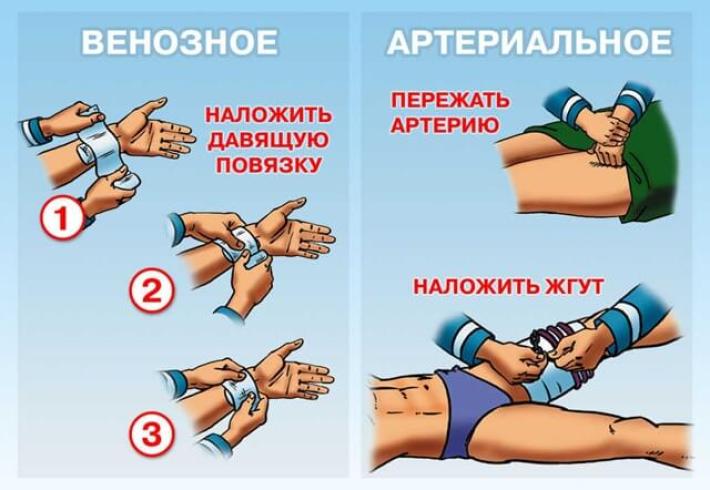Types of bleeding and first aid rules you need to know!

Bleeding - the release of blood beyond the vascular bed or the heart into the environment (external bleeding), into the body cavity or lumen of the hollow organ (internal bleeding). Examples of external bleeding are metrorrhagia (uterus), melena (intestinal), internal - hemopericardium, hemothorax, hemoperitoneum, hemarthrosis (respiratory cavity, pleural cavity, abdominal and articular cavity, respectively).
The need for first aid in bleeding is caused by danger to human health and life. It is important not only to know what the danger of bleeding is and what kind of help a wounded person needs, but also to be able to determine the type of bleeding . On the characteristic features of the types of bleeding and how to provide first aid in case of their occurrence later in the article.
Types of bleeding - characteristic features
Since first aid for venous bleeding differs from first aid, say, with arterial bleeding, it is necessary to clearly understand, with the damage which vessels you encounter.
There are four main types of bleeding :
- Capillary;
- Venous;
- Arterial;
- Internal.
The risk of bleeding is:
- Acute hemorrhage;
- Risk of infection;
- Formation of pulsating hematoma;
- Penetration of air into the damaged vessel.
Determine the type of bleeding :
- Capillary (insignificant and uniform allocation of blood from the damaged surface).
- Venous (uniform and rapid flow of dark red blood without signs of flowing, it is possible to form clots).
- Arterial (pulsating (sometimes intermittent) jet of bright red blood that flows with great speed).
- Internal (pallor of the skin, cold sweat, dizziness, weak pulse, fainting, shallow breathing, blood does not flow out). If the bleeding is localized in the lungs, blue skin and mucous membranes are observed, rapid and / or shortness of breath, coughing up with blood. Bleeding to the abdominal cavity can manifest, in addition to the main symptoms, vomiting with blood, tachycardia, and lowering of pressure. Hematomas occur in case of a hemorrhage into the large muscles.
First aid rules depending on the type of bleeding
As a rule, the maximum danger of capillary bleeding lies not in blood loss (it is minimal), but in infection .
Therefore, if small vessels are damaged,
- Wash the wound with water (naturally, clean);
- To treat the edges of the wound with an antiseptic;
- Impose a gauze bandage.
If you have determined that you are dealing with venous bleeding , the procedure for this type of bleeding is as follows:
- Application of a pressure bandage (aseptic);
- If the pressure bandage does not help, a tourniquet or a twisted towel, a belt, etc., is applied to the soft lining. (The location is below the damaged area) with a note attached with the time of imposition; Leave the tourniquet for no more than 1 hour in cold weather and no more than 2 hours in hot weather.
One of the most dangerous types of bleeding is considered arterial , because in this case the risk of death as a result of blood loss is significantly increased. In this case it is necessary:
- Only in the absence of fractures - raise the limb;
- Apply a tourniquet (or its analog) above the injury site;
- During the search for material for the harness, you can press the artery (also above the fault location) at the ripple point;
- If the integrity of certain arteries (humerus, elbow, popliteal or femoral) is violated, the limb can be raised and fixed in a bent position.

If the symptoms suggest the presence of internal bleeding , it is necessary to ensure the immobility of the victim, namely:
- With a hemorrhage in the thoracic region - the position of the half-sider's + cushion under the knees;
- With a hemorrhage in the abdominal cavity - lying position.
A little to ease the bleeding will help the cold, which is applied to the alleged site of localization of bleeding.
An ambulance should be immediately called for in any type of bleeding, except capillary. Remember that to climb into the wound with your hands, try to remove from it any objects or remove the blood-soaked bandage is prohibited.
Via estet-portal.com


Comments
When commenting on, remember that the content and tone of your message can hurt the feelings of real people, show respect and tolerance to your interlocutors even if you do not share their opinion, your behavior in the conditions of freedom of expression and anonymity provided by the Internet, changes Not only virtual, but also the real world. All comments are hidden from the index, spam is controlled.